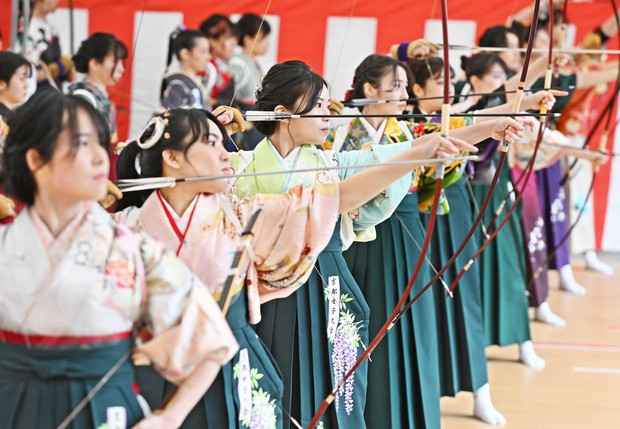Japan is known for its elaborate New Year celebrations, which typically begin on December 31 and continue through the first few days of January. Visitors can experience traditional customs such as visiting shrines and temples, participating in festive parades, and watching fireworks displays. January is the peak season for its winter activities. It is also famous for its winter sports, such as skiing and snowboarding. Visitors can enjoy the beautiful snowy landscapes during this month and experience Japan’s vibrant culture and traditions. This guide will tell you the best way to enjoy visiting Japan in January.
1st January– Japanese New Year

Japan’s New Year’s festival, Shogatsu, is perhaps the most significant event in the Japan in January. It has been held on January 1 since 1873, when the country embraced the Gregorian calendar over the previously utilized lunar cycles. Shogatsu is linked to Shinto beliefs that kami, also known as spirit gods, visit households during this time. It is celebrated with solemnity and yet in a joyful mood. The streets are decorated with New Year decorations of pine and plum branches, bamboo stalks and ropes with paper garlands. People pay homage to gods in shrines and visit friends and relatives to exchange greetings.
While Shogatsu is the general word for celebrations, there are several unique customs to look out for. It includes Hatsuhinode, Hatsumode, Omamori for good luck charms, and Shishimai, which is a traditional lion dance. The first dawn of the year is Hatsuhinode. People congregate at designated sites with an excellent view of the horizon to catch the Hatsuhinode, believing that catching a glimpse of the dawn will help assure good fortune and happiness in the following year. We recommend that you go to the nearest shrine while visiting Japan in January.
3rd January– Ball-Catching Festival

The main attraction of this festival during your visit to Japan in January is a fight between two groups of people to catch a sacred wooden ball. The celebration is believed to bring good luck to the winning team for the year. Hakozaki Shrine, together with Iwashimizu Shrine in Kyoto and Usa Shrine in Oita, is one of the three famous Hachiman shrines in Japan, and they hold the yearly shrine festival of “Tamatori-sai” or “Tamaseseri” magnificently.
It is well-known in Japan and one of the three major festivals in Kyushu. Tamatori-sai festival is claimed to have begun roughly 600 years ago, during the Muromachi era. Starting at 1 p.m., two wooden balls to denote Ying and Yang are taken to the subordinate shrine of Tamatori Ebisu Shrine located approximately 250 metres to the east of the main shrine. After the celebration, the Yang ball is delivered to Seriko, half-naked and dressed in loincloths, and the Tamaseseri begins.

Every year on January 6, Tokyo Metropolitan Fire Department personnel march in a parade to welcome the New Year. The Dezome-Shiki, also known as the New Year’s Parade of Firemen, is a New Year’s Eve event conducted at Tokyo Big Sight (the largest exhibition centre in Japan) in Koto City, Tokyo. The Tokyo Metropolitan Fire Department hosts the parade to warn the citizens about fire hazards and pray for a secure New Year. Its origins trace back to the Edo era (1603-1868), when many large fires ravaged Edo (modern-day Tokyo), destroying most of the city.
Following a major fire in 1657, the jobikeshi fire brigade was established to safeguard the city and vital places such as Edo Castle, with fire corps stationed full-time at four locations. The Dezome-Shiki features a parade of over 100 Tokyo Metropolitan Fire Department vehicles and helicopters, high-tech fire-fighting equipment, emergency drills, and various spectacular performances, including a display of Cirque du Soleil-style death-defying ladder stunts. The incredible ladder stunts have a lengthy history and are the event’s centrepiece and significant attraction. Ladders were essential equipment during the Edo era because firefighters had to ascend the roofs of buildings rapidly and nimbly to prevent flames from spreading to surrounding structures.
7th Janaury– Usokae Festival

Every year on January 7, people exchange wooden birds during the Dazaifu Tenmangu ritual, which takes place before the Onisube fire festival later that day. It consists of miniature sculptures of bullfinches known as Uso in Japanese. These birds are the messengers of Sugawara Michizane, or Tenjin, the shrine’s god. Uso may also mean “lie,” and because Sugawara Michizane was known for his sincerity and honesty, trading these wooden carvings represents exchanging your lies for the deity’s blessings. The ritual begins with people gathering around a vast wooden bullfinch in the courtyard. They then form a circle around the bullfinch, singing “kaemasho kaemasho” and transferring the little sculptures from person to person, and it moves from one hand to another among the people.
After the ritual, you can take one of the wooden birds home to bring joy and good fortune the following year. With a nominal payment, everyone can attend the ceremony. From 5 p.m., go to one of the designated counters to pay for your gift and collect your carved uso. The ceremony begins at 6 p.m. Later that evening, the grounds host the Onisube festival, one of Japan’s grand fire celebrations.
9th January –11th January – Toka Ebisu Festival

Thousands of people pray for a prosperous New Year’s business. Ebisu is the patron deity of business and good fortune. The festival features a procession of women in colourful kimonos, carried in palanquins, through the Main Streets. Yoi Ebisu (business prosperity patron deity) gathers devotees throughout three days, with Yoi Ebisu on the 9th, Hon Ebisu on the 10th, and Nokori Ebisu (remaining fortune) on the 11th. During the three days of the festival, one million worshippers pray for economic success to obtain from good luck girls bamboo from Fuku-Musume (Lucky Girls) to the accompaniment of Hayashi music and the words, “Shobai-hanjo de sasa mottekoi!”
Locals customarily spend the 9th day at home peacefully before washing their hands and attending the shrine when it reopens on 10th. After the gates open, the rush to get to the main shrine becomes a literal race. One hundred eight runners are picked at random to lead the pack, and at 6:00 a.m., the main gate opens, and they dash for 230 metres across the grounds to the shrine hall. The first three are the lucky men, but there is no need for them to be males who get rewards such as an Ebisu statue, beer, and rice and can look forward to good fortune in the next year.
The Fukuoka marathon draws a large crowd of onlookers who watch the runners start and then follow behind them to see the winners announced and to pray to the temple themselves. This event has grown so well-known that it is televised on Japanese television.

In Japan, children are considered adults on their 20th birthday. Seijin no Hi is a Japanese public holiday observed annually on the second Monday of January. Until 1999, it was observed on January 15. The goal of this holiday is to celebrate and encourage young men and women who acquire the legal age of maturity. They have to meet their new-found obligations and become self-reliant members of society.
During the event, local government leaders and guest speakers give speeches. Gifts are also given to the new adults. Women commemorate the day by wearing unique kimonos with long sleeves instead of the kimonos with shorter sleeve sections worn by mature, married women. Some ladies will also dress in hakama (baggy pants) So expect some traditional vibes during this time visiting Japan in January.
The custom of Coming of Age Day may date back to the 700s. However, the more contemporary version started in the 1600s. Boys would participate in genpuku rites, while ladies would participate in Mogi ceremonies. They would dress in adult robes and have their hair chopped. After World War II, the holiday took on a new meaning when the city of Warabi, near Tokyo, sponsored a youth festival to cheer people up. Coming of Age Day has been declared an official holiday in the United States since 1948. As part of Japan’s “Happy Monday” scheme, which shifted various holidays to create three-day weekends, it moved to the second Monday in January 1998.
17th January – Bonden Festival

During this local celebration, groups of young adults carry bonden, 3.5-meter-long sacred wands, to Taiheizan Miyoshi Shrine. Miyoshi bonden Festival, popularly known as “Bonden Fighting,” is held at Mt. Taihei Miyoshi Shrine. Men scuffle fiercely as they make Bonden sacrifices to pray for a plentiful crop and good health for their families.
The teams rush to be the first to reach the shrine with their bonden after which the visitors swarm the winners to touch the charms that adorn the wands and the players for good luck and strength. Miyoshi Reijin, also known as the God of Power, is one of Mt. Taihei Miyoshi Shrine’s main deities. He supposedly enjoys a good fight that’s why the festival’s moniker is “Bonden Fight”.
Closest Sunday after January 15 – Toshi-ya

The Sanjusangendo temple’s most significant celebration, the Yanagi-no-Okaji, or Rite of the Willow rite, is held on the second Sunday of January. The Tshiya, means the passing arrow or the arrows that hit the target. It is an archery competition conducted on the west courtyard of Kyoto’s Sanjsangen-d temple. The competition dates back to 1606 when a samurai called Asaoka Heibei is claimed to have fired 51 arrows. Initially, archers shot arrows from the veranda’s southern end to the northern end.
During the Edo era, the event grew in popularity, and by the late 17th century. The matches between contestants from the Owari and Kish provinces drew large crowds. On Sunday, around 1,600 women participated in the 2023 annual New Year archery tournament in Kyoto. The women compete in an archery event (kyudo in Japanese) by shooting at a one-meter-wide target. Each archer receives two arrows and two minutes to hit the targets. Those that successfully strike the target with both hands advance to the next round.

In the evening twilight, a trumpet signals the setting ablaze of Wakakusayama Hill in Nara Park. Every year on the fourth Saturday of January, the holy Mt Wakakusayama is set ablaze. This is a traditional re-enactment of a fabled border dispute between the Kofuku-ji and Todai-ji temples in Nara City. This can be an amazing time to end to your visit japan in january
Naturally, you can’t enter Mt Mikasayama during this event. The Yamayaki is a renowned festival in Japan. Monks transport the sacred fire to the hill and light it, which results in a half-hour of pyrotechnics. The conflagration can be seen for kilometres, but the sights are most spectacular in Nara, which oversees the fire.















































